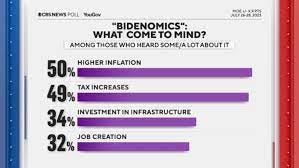As the 2024 election approaches, Democrats have a three-point plan for their challenging quest to re-elect Joe Biden, take back the House, and defend their razor-thin Senate majority. The first two points one might characterize as the Democrats’ version of the culture war: (1) relentless attacks on Republicans’ association with abortion restrictionism, usually portrayed as a GOP drive to ban the procedure entirely; and (2) equally relentless attacks on the Republicans as destroyers of democracy, from Trump’s and his supporters’ “election denialism” to “MAGA” movement rhetoric and legislation said to be subverting democracy across the country.
The theory is that these attacks will neutralize and then some Republican messages on crime, immigration, race, gender and schools, where Democrats are easily associated with genuinely unpopular positions. The 2022 elections and special elections since are believed to provide a precedent for this approach. But then we have the third prong of the Democratic strategy: a bold attempt to sell Democrats’ stewardship of the economy as “Bidenomics.”
On one level, this can only be described as chutzpah. A massive tranche of poll findings uniformly find the public extremely unhappy with the state of the economy. In a particularly brutal recent poll from Washington Post/ABC News, Biden receives a dreadful 30 percent approval rating on handling the economy. It’s instructive to break this down by working class (noncollege) vs. college educated. Working-class respondents give Biden a 24 percent approval rating on the economy, way below the comparatively respectable 43 percent rating among the more upscale college educated group. Since Bidenomics has been explicity pitched as a way to build working-class enthusiasm for Biden’s candidacy, this signals a rather big problem with the strategy.
Similarly, the Post poll finds a mere 25 percent characterizing the national economy positively (excellent or good), with just half as many (19 percent) feeling that way among the working class as among the college educated (38 percent). And a rock-bottom 14 percent of working-class respondents say their personal financial situation is better now than when Biden took office, compared to 50 percent who say they are actually worse off.
The second wave of The Liberal Patriot/YouGov (TLP/YouGov) 2024 presidential election project was completed in early September, including interviews with more than 3000 registered voters. These new data flesh out how and why Bidenomics has been such a flop with voters. Start with the issue of inflation. As we noted in our post yesterday, voters overwhelmingly feel that inflation is “still a very serious problem that is not improving,” with working-class voters particularly likely (68 percent) to feel that way.
These sentiments baffle Democrats who note that the rate of inflation has actually been falling and that unemployment is super-low. So why aren’t people, particularly workers, happy? It’s very simple as liberal economist James K. Galbraith has noted:
Unlike unemployment, inflation does affect everyone. But what matters to working people is not the monthly or yearly price change taken alone. What matters is the effect on purchasing power and living standards over time. Whether these are rising or falling depends on the relationship of prices to wages. When wage growth exceeds price increases, times are generally good. When it doesn’t, they aren’t.
It is here that Biden has a problem. During his presidency, living standards have not risen. From early 2021 to mid-2023, prices have increased more than wages, implying that real (inflation-adjusted) hourly wages and real weekly earnings have fallen, on average. Not by much, but they have fallen. Worse, the average figure probably masks a larger fall, in real terms, for families that started out below the average. And given how income distributions work, there are always many more families earning less than the average than there are who earn more.
In other words, it is the trajectory of workers’ living standards, not misinformation or media framing, that explains why they see the economy of the Biden administration in such jaundiced terms. And why they tend to think Trump actually did a better job managing the economy. In the new TLP/YouGov poll, working-class voters prefer Trump’s economic management as president by 20 points (55 percent to 35 percent), again contrasting with the college educated who prefer Biden’s performance by 9 points (51percent to 42 percent).
Given all this, it should not be surprising that the very term the Democrats are seeking to popularize—”Bidenomics”—is not striking a responsive chord. On the contrary, the lack of enthusiasm is deafening. In the TLP/YouGov survey, a mere 28 percent of working-class voters are willing to say they support Bidenomics, just 29 percent think Bidenomics will help their family financially, and scarcely more (32 percent) believe Bidenomics will help the overall economy.
Interestingly, Bidenomics support lags significantly behind support for specific legislative measures passed by the Biden administration, especially the Inflation Reduction Act and the Bipartisan Infrastructure Act. Since these were unaided questions—that is, no descriptions of the bills were given, just the names—voters may partially have been reacting to things they already feel positively about like “inflation reduction,” “bipartisan,” and “infrastructure,” rather than the content of the bills themselves. But that in itself is a clue to what voters are looking for. The term “Bidenomics,” on the other hand, with its absolutely inevitable association with economic conditions voters, especially working-class voters, detest seems perfectly designed to annoy voters, rather than win them over.
A new NBC poll shows Republicans currently favored over Democrats on handling the economy by an astounding 21 points, the largest lead Republicans have had on this measure since 1991. That tells you about how well the Bidenomics messaging campaign is working so far. The Democrats would be wise to try a different approach—one that doesn’t rely on telling voters they should be happy when they are not.




